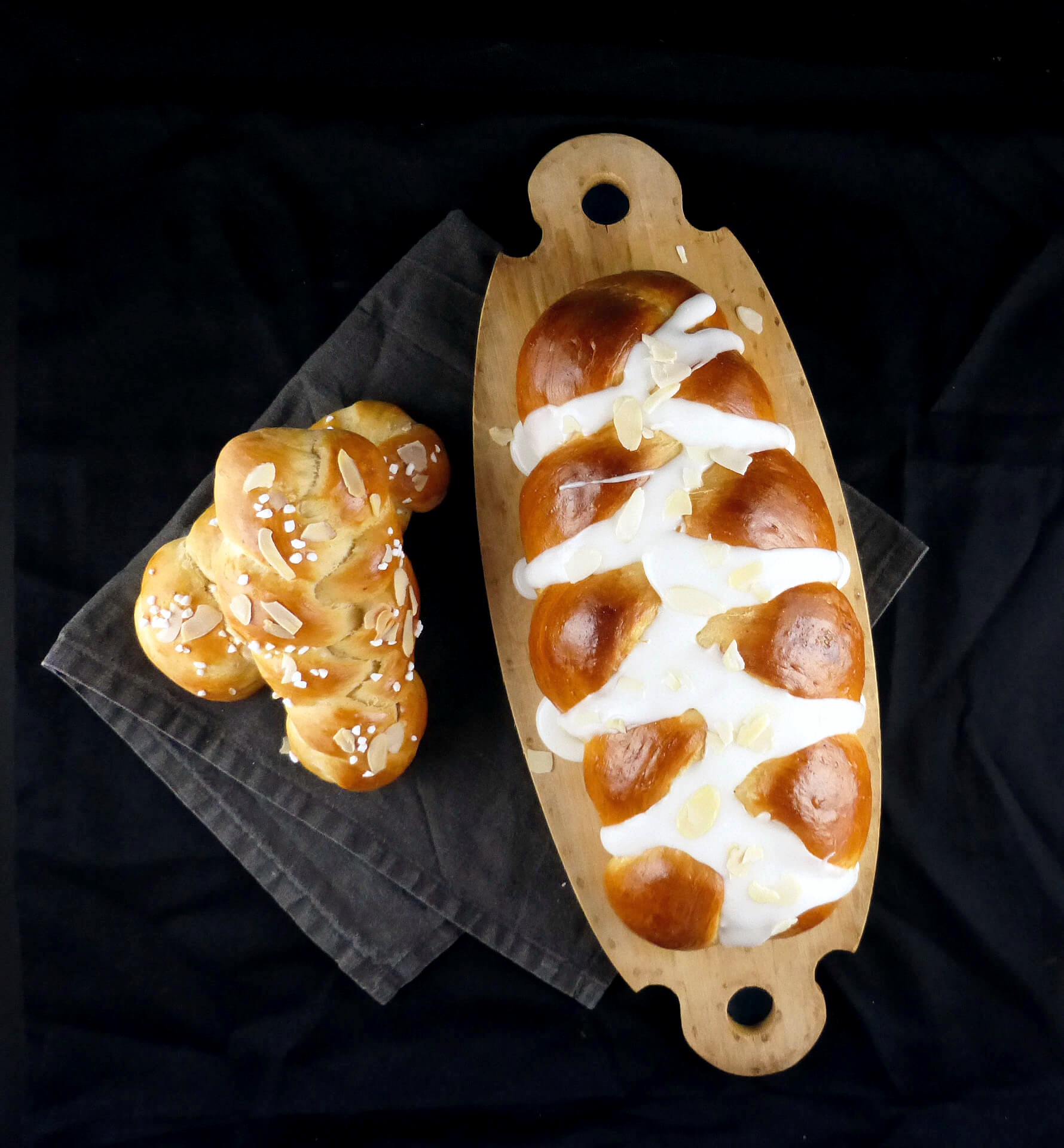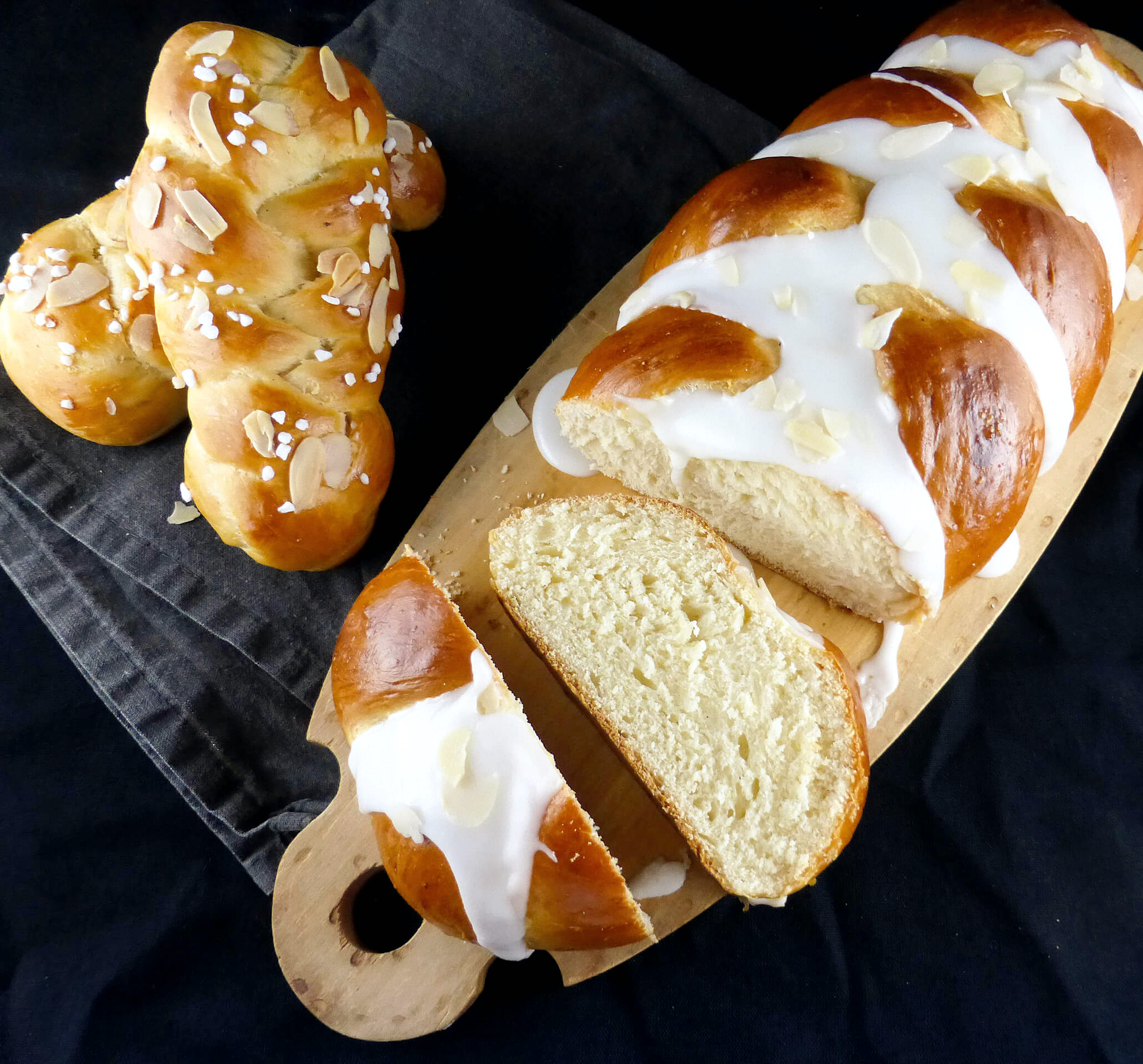Spelt Cardamom Braided Bread
Soft, fragrant, and gently sweet, Spelt Cardamom Bread is a beautiful celebration of Nordic-style baking. The dough is subtly spiced with cardamom and enriched with butter, egg and milk, giving it a soft, tender crumb. You can shape it into a braided loaf with a thick vanilla drizzle, or form it into smaller buns topped with pearl sugar and sliced almonds. Whether you make one large loaf or a batch of pretty little plaits, this bread is as lovely to look at as it is to eat.
Some of the links in this post might be affiliate links. Please read my disclosure and privacy policy for more information.
_________
|
|
| What is cardamom? |
| The history of cardamom in nordic baking |
| Preparing the dough |
| Adaptations for this cardamom bread |
| More sweet bread recipes |
What is cardamom?
Cardamom is a spice that comes from South East Asia and belongs to the ginger family. Sometimes referred to as the queen of spices, it grows in small pods, which can be green, black or white (green being the most common). Inside each pod are tiny black seeds, and it’s these seeds that hold the strong, unmistakable flavour of cardamom.
Both the whole pod and the seeds can be used in cooking, often in savoury dishes like curries or rice. While cardamom is typically associated with savoury dishes in many parts of the world, it’s a much-loved baking spice across the Nordic countries, especially in Sweden and Finland, where it’s often added to sweet buns, cakes, and festive breads.
The flavour is warm, slightly citrusy, and deeply aromatic. Though fairly strong, even a small pinch can bring a lovely depth to bread, bringing a cosy, comforting note that’s instantly recognisable in Scandinavian baking.
The history of cardamom in nordic baking
Cardamom has a rich history as a spice, especially in baking. Ancient cultures first used it for its medicinal properties, but over time, cooks began adding it to food. The spice became a key part of culinary traditions across the Middle East, South Asia, and Europe.
Traders likely introduced cardamom to Europe during the Middle Ages, along with other spices like pepper, cinnamon, and cloves. The Vikings, known for their trading and exploration, may have brought cardamom to Scandinavia during their travels east. Records show that cardamom featured in Scandinavian trade as early as the 11th century. By the 16th century, Swedish recipes began to include it.
In Sweden, cardamom became a key ingredient in festive bakes like semlor, lussekatter and pepparkakor, often associated with specific holidays and seasons. By the 19th century, the spice had firmly cemented its place in Swedish baking, especially in the preparation of rich, sweet breads. Its popularity in Sweden and Finland was likely influenced by a combination of cultural exchanges, evolving food traditions, and the widespread availability of imported spices.
Using cardamom in bread was a natural progression, as its warm, aromatic flavour complements rich doughs and enhances their sweetness. It’s especially popular in Scandinavian baking due to its ability to pair so well with butter, sugar, and flour which are common ingredients in Nordic bread recipes.
Preparing the dough
One of the best things about this spelt cardamom bread is how flexible it is to make. You can prepare the dough using a bread machine, a stand mixer, or knead it by hand if you like a more hands-on method. I’ve included detailed instructions for both the stand mixer and bread machine, so you can choose the option that suits you best.
The bread machine is ideal if you want something quick and easy. Just add the ingredients to the pan and let the machine handle the mixing and kneading. If you’re using a stand mixer, the dough comes together quickly with the dough hook. It gives an even, smooth texture without much effort.
Prefer the traditional route? Kneading by hand is always an option. It’s satisfying to work the dough yourself until it becomes soft and elastic. However you choose to prepare it, you’ll end up with a beautifully spiced, soft cardamom bread. The texture is just right and perfect for shaping into whatever style you like.
Adaptations for this cardamom bread
For this spelt cardamom bread, I decided to try two different variations: a large, braided loaf and five smaller, individual buns. Both versions were plaited, but I had a little fun with the toppings to make each one unique. The larger loaf received a generous vanilla drizzle frosting, which added a rich sweetness that perfectly complemented the warm, spiced cardamom. I topped it off with a sprinkling of sliced almonds, adding both crunch and a touch of elegance to the bread.
The smaller buns, on the other hand, were coated with a delightful combination of sliced almonds and pearl sugar. The pearl sugar gave them a lovely sweetness and a satisfying crunch, while the almonds added a nutty depth. These individual portions were perfect for sharing or for those who prefer smaller, more bite-sized treats.
While both versions were absolutely delicious, I found myself particularly drawn to the larger loaf. The combination of the soft, fluffy bread and the indulgent vanilla frosting was simply irresistible. The frosting provided a touch of sweetness without overwhelming the spiced dough, making it the perfect balance of flavors. Whether you choose to make a large loaf to share with friends or the smaller buns for individual servings, both versions of this cardamom bread are sure to be a hit.
Spelt Cardamom Bread (made two ways)
Ingredients
Dough (see note 1):
- 250ml (1 cup) milk
- 50g (3½ tbs) butter
- 1 egg (medium)
- 400-450g (3⅓ - 3¾ cups) spelt flour (see note 2)
- 50g (¼ cup) sugar
- 1 tsp ground cardamom
- 7g (2¼ tsp) dried yeast (see note 3)
- ½ tsp salt
- 1 beaten egg (for an egg wash before baking)
Additional Ingredients:
- 1 tbsp milk
- 1 tbsp vanilla extract
- icing / powdered sugar (enough to make a very thick paste)
- sliced almonds
- pearl sugar
Instructions
DOUGH
Bread Machine:
- Add the milk, butter, and egg to your bread machine pan.
- Then add 400g (3⅓ cups) of flour and the remaining ingredients. Try to keep the yeast and salt separate as much as possible.
- Set your machine to the dough setting.
- On a well-floured surface (the dough will be very sticky), work in just enough extra flour to make a soft, pliable dough that still feels slightly tacky.
Stand Mixer:
- Add the milk, butter, and egg to your stand mixer bowl and give it a quick mix. If the butter is straight from the fridge, it may not combine fully with the liquids, but that’s fine.
- Add 450g (3¾ cups) of flour and the remaining ingredients. The dough should be sticky, but if you need more flour, add it gradually. Be careful—too much flour will make the bread dry.
- Switch to a dough hook (if you have one) and knead for about 10 minutes, just until the dough is soft. It should still feel slightly tacky but should slowly pull away from the hook.
- Cover the bowl and leave the dough to rise until doubled in size (usually about an hour).
- Once ready, knock the dough back and form it into a rough ball on a floured surface.
Small Cardamom Breads:
- Using half the dough (see note 4), divide it into 5 equal portions.
- Divide each portion into three pieces and roll each one into a thin rope about 15cm / 6 inches long.
- Pinch the three ropes together at the top and plait (braid) them. Tuck both ends under.
- Repeat with the remaining dough, so you end up with five small plaited buns.
- Preheat the oven to 175°C (350°F) and line a large baking tray with parchment paper.
- Place the buns on the tray, allowing space between them.
- Cover with a tea towel and let them rest for around 30 minutes.
- When ready, brush with egg wash and sprinkle with sliced almonds and pearl sugar.
- Bake for about 12 minutes, until golden brown. Remove from the oven and serve warm.
Large Cardamom Plait (Braid)
- Using the remaining dough (see note 4), divide it into 3 equal parts.
- Roll each piece into a thick rope about 25cm (9¾ inches) long.
- Pinch the ends together at the top and plait (braid) them. Tuck both ends under.
- Preheat the oven to 175°C (350°F) and line a large baking tray with parchment paper.
- Place the plaited dough on the tray and cover with a tea towel. Leave to rest for about 30 minutes.
- When ready, brush with egg wash.
- Bake for 15–20 minutes, or until golden brown. Remove from the oven and allow to cool.
Drizzle (see note 5)
- Mix the milk and vanilla extract together, then add enough icing sugar to make a thick, slow-dripping paste.
- Drizzle it along the lines of the plaited loaf. Sprinkle with sliced almonds. Slice and enjoy!
Notes
- I have made the dough using both a stand mixer and bread machine with identical results. I have not made the dough by hand, but I see no reason why you couldn't do so!
- You can use spelt or regular flour for this recipe (just use the same amount).
- In Sweden we have something called dried yeast. It is used both in warm liquid to proof and also added directly to flour. I am aware that the US has two options for dried yeast, and I believe instant yeast is the most similar to our dried yeast.
- The dough will make 5 small buns and one larger one. However, you could use the dough any way you like, perhaps making 10 small buns or just one large loaf.
- I used an icing drizzle only on the large loaf. Of course you can use it on the smaller ones, too.







